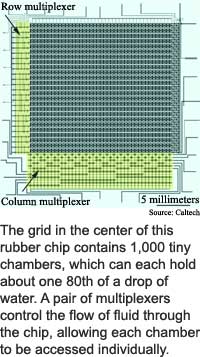|
Molecular at heart - News continues to emerge from various computer labs pursuing smaller and smaller physical logic switches. Important was work reported last week by an IBM lab that achieved what was described as molecular cascades. Molecules move across a copper surface to perform logical calculations.
If work like this truly bears fruit, then silicon computing can continue to improve.
As electronic efforts move to the molecular level, interest in biological computing, which is molecular at heart, will grow. |
|
Although recent weeks have seen some recent molecular breakthroughs recast as counterfeit research, there continue to be advances on this front as well.
Notably, Cal Tech researchers developed chips with plumbing networks sporting thousands of micromechanical valves with 'addressable' chambers. These are fluidic systems, described as microfluidic large scale integration chips, as small, in fact, as a human thumbnail, that can improve lab work requiring bimolecular separations, enzymatic assays, and such. The very small 'hydraulic' multiplexers the group has fashioned support comparator arrays; and memory storage devices are envisioned as well.
Computing at the molecular level has a way to go; but it is beginning to happen, and, as with electronic circuitry in the '50s and 60s', this small stuff could eventually effect culture in society in the large. |
 |
